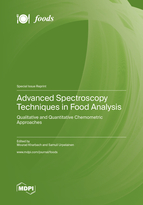Advanced Spectroscopy Techniques in Food Analysis: Qualitative and Quantitative Chemometric Approaches
A special issue of Foods (ISSN 2304-8158). This special issue belongs to the section "Food Analytical Methods".
Deadline for manuscript submissions: closed (31 January 2023) | Viewed by 29543
Special Issue Editors
Interests: spectroscopy; foods; statistics; chemometrics; material sciences; climate change; catalytic reactions; mixture analysis
Special Issues, Collections and Topics in MDPI journals
Special Issue Information
Dear Colleagues,
Due to the globalization of the food market, food producers must satisfy consumers while fulfilling the required food safety and quality standards. Food quality analysis may include, among others, chemical characterization, physical properties, sensory evaluation, authentication, origin traceability, processing, harvest, storage, microbiological and toxic contamination. Food analysis is the process that controls all the sub-mentioned steps, in which traditional analytical techniques are widely used. However, conventional analytical techniques use destructive procedures, which are laborious, time-consuming, expensive and contaminating. In this context, advanced spectroscopic techniques, for instance, X-ray-based methods, hyperspectral and multispectral imaging, NMR, Raman, IR, mass, UV, visible and fluorescence, are non-destructive, fast, use less solvent, environmentally friendly and inexpensive. Statistical analysis including chemometric approaches (preprocessing, exploration, variable selection, classification, regression and data fusion) is crucial to extract and investigate the relevant information hidden in the spectra (fingerprints) or image data. In addition, the extracted information (spectral features) from one or multiple spectroscopic sources allows the construction of calibration models that may serve for qualitative and or quantitative analysis of studied foods. Advanced spectroscopic techniques and chemometric tools may have great application in food science and technology, as well as in achieving consumer confidence.
This Special Issue will address and publish the recent advanced spectroscopy techniques focused on their use in the food analysis, quality evaluation, safety assessment and practical industrial applications, with an emphasis on chemometric approaches.
Dr. Mourad Kharbach
Dr. Samuli Urpelainen
Guest Editors
Manuscript Submission Information
Manuscripts should be submitted online at www.mdpi.com by registering and logging in to this website. Once you are registered, click here to go to the submission form. Manuscripts can be submitted until the deadline. All submissions that pass pre-check are peer-reviewed. Accepted papers will be published continuously in the journal (as soon as accepted) and will be listed together on the special issue website. Research articles, review articles as well as short communications are invited. For planned papers, a title and short abstract (about 100 words) can be sent to the Editorial Office for announcement on this website.
Submitted manuscripts should not have been published previously, nor be under consideration for publication elsewhere (except conference proceedings papers). All manuscripts are thoroughly refereed through a single-blind peer-review process. A guide for authors and other relevant information for submission of manuscripts is available on the Instructions for Authors page. Foods is an international peer-reviewed open access semimonthly journal published by MDPI.
Please visit the Instructions for Authors page before submitting a manuscript. The Article Processing Charge (APC) for publication in this open access journal is 2900 CHF (Swiss Francs). Submitted papers should be well formatted and use good English. Authors may use MDPI's English editing service prior to publication or during author revisions.
Keywords
- food quality
- food authenticity
- food contaminants
- foodomics
- spectroscopy
- chemometrics
- multivariate analysis







